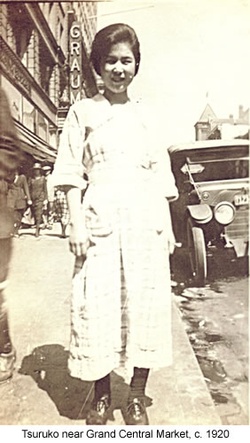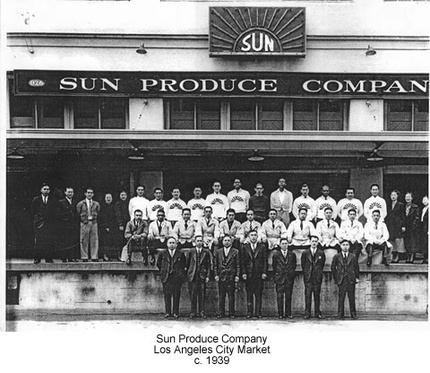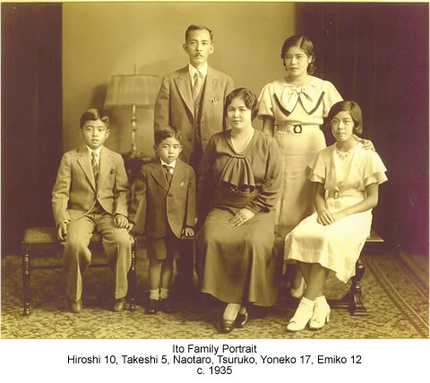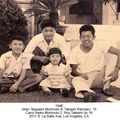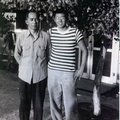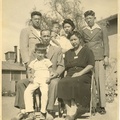>> Part 1
In the years following, the couple lived very frugally and carefully saved practically every dollar they earned, hoping for a good business opportunity. Naotaro worked as a cook at Booz Brothers Cafeteria on Hill Street and Third. Also working there were Matsushi Naruse and Senenmon Tsunekawa both men also of Aiichi Prefecture and equally anxious to start a business. Noticing the volume of business at Grand Central Market which was adjacent to Booz Brothers, all three men leased stalls to sell produce at the market. Although the exact date is not known, this was probably in 1919 or 1920. These businesses proved to be extremely profitable, and the three men decided to pool their resources to form a wholesale produce business that would supply produce not only to their stalls at Grand Central but to other retail produce stores as well. This was the genesis of the Sun Produce Company that would ultimately become the largest wholesale produce business at the Los Angeles City Market prior to World War II.
Both the businesses at Grand Central Market and Sun Produce continued to be very profitable. During this period, Tsuruko gave birth in 1921 to a son, Takashi, who was still born because Tsuruko accidentally fell during pregnancy causing a premature birth. Fortunately, Tsuruko became pregnant again shortly thereafter, and another girl, Emiko was born in 1922. A long-awaited son, Hiroshi was born three years later in 1925. In 1927, Naotaro and Tsuruko, with the family now complete, decided to return to Japan and retire and purchased a large home in Ashiya, a resort community outside of Kobe. Yoneko, Hideko, and Tsuruko’s mother joined them to live in Ashiya. Tsuruko’s niece also came to help with the housework. After he got the family settled in Ashiya, Naotaro returned to Los Angeles intending to rejoin the family as soon as he was able to settle his business matters.
In Ashiya, Tsuruko was finding the adjustment to a leisurely life and the social life in Ashiya very difficult. In America she was used to a very informal lifestyle whereas in Ashiya, housewives were expected to observe a very formal and restricted lifestyle. In addition, the neighbors did not accept her because the family was nouveau riche and only recently returned to Japan after living a life as immigrants in America. Tsuruko felt outraged by this attitude and decided to leave Ashiya and return to America.
She notified Naotaro of her plans and immediately prepared the family to leave. Unfortunately she learned that Hideko would have to be left behind in Japan with her mother because she did not have U.S. citizenship, being born in Japan. This was a terrible blow to both Yoneko and Hideko since they had been inseparable since Hideko’s birth. The infamous Tokujiro was again in the picture. He convinced Tsuruko that he was employed by a major Osaka newspaper and that he would use his influence to obtain special permission to allow Hideko to join the family in America. According to Hideko the departure of the Yoneko at this time (she was 12 and Yoneko was 14) was among the saddest experiences of her life. To make matters worse Tokujiro’s claim was a hoax, and he later tricked Tsuruko’s mother and Hideko to move from the family home in Ashiya so that he could move in, under the guise that this would better enable him to sell the property for Naotaro. He may have sold the property, but he never turned over the proceeds to Naotaro. Tsuruko remained outraged the rest of her life and Tokujiro became persona non grata to the other members of Naotaro’s family.
The family returned to Los Angeles in 1927 and Naotaro’s business at Grand Central Market continued to prosper. Naotaro had started the business with a Mr. Sasaki but he passed away at a relatively young age and his widow became a working partner. Along with a manager, Mr. Kitayama, the business ran smoothly under Narotaro’s general supervision.
Naotaro’s major endeavor was the Sun Produce Company. This company continued to grow and prosper and was before the beginning of World War II, the largest Japanese wholesale produce market at the Los Angeles City Market. Organizationally, Matsushi Naruse was the president, performing as the administrative officer and maintaining liaison with farmers; Naotaro Ito was vice-president and served as the chief buyer of fruit within the market; Senenmon Tsunekawa was in charge of the retail stores owned by Sun; Gene Sasaki served as the floor manager; Mr. Shibata was the dispatcher; and Mr. Ohama was in charge of the yard operations. The total staff numbered 50 employees plus office personnel.
Being new to the United States, Yoneko’s adjustment was difficult. For one thing, she had to learn a new language by attending a special school. On top of that, Tsuruko was not much interested in housework and day-to-day duties as a mother; she tended to rely heavily on Yoneko’s help. In fact, Yoneko began to feel more like a maid and nanny than a daughter. When Takeshi was born in 1929, she practically became a surrogate mother to Takeshi. Yoneko took most of the childhood pictures taken during this time. She completed a dress design school that was very useful in many ways. She not only designed and made her own wedding dress, she made most of the dresses of her three daughters as they were growing up. Yoneko was married to Hiromichi Morimoto in 1937. All members of the family owe her a great deal for all her help and caring concern throughout her lifetime.
In 1934, arrangements were finally made whereby Hideko could join the family in America. However, in the meantime she had met someone, the brother of her friend, whom she wanted to marry and no longer wanted to leave Japan. After attempting to change her mind, Naotaro and Tsuruko consented to the marriage, and Tsuruko went to Japan to attend the wedding taking Takeshi along. Takeshi still remembers meeting Hideko for the first time in Yokohama at the age of five when the ship had just docked. Tsuruko and Takeshi stayed in Japan for six months. Following the wedding in Matsuyama, curiously they accompanied the bride and groom on their honeymoon trip to various scenic places in Japan.
In 1935, Naotaro bought a large two-story frame house at 2011 South La Salle Avenue near the intersection of Washington Boulevard and Normandie Avenue in west central Los Angeles. He named Hiroshi and Takeshi as owners of the property, because Japanese nationals were not allowed to own any land due to the existing discriminatory land law. At that time, this was a predominantly white middle class neighborhood. The Naruse family also bought an even larger house in the same general neighborhood.
The schools attended by the children, 24th Street Elementary and later Mount Vernon Junior High, had very few minority group students and only two other Nikkei children. James Naruse recalls being discriminated against by a certain teacher at 24th Street School, but Takeshi had no such experience.
In 1937, Emiko became very ill. After catching a heavy cold she was afflicted with rheumatic fever. The family doctor did not diagnose the problem correctly, and it was not until a consulting physician began proper treatment that her condition improved. In the interim, Tsuruko and Naotaro were willing to try anything to find a cure for Emi including attending Seicho-no-iye (a Japanese religion) meetings and calling on any others for their help. After a long convalescence, Emi recovered and returned to school completing high school and attending UCLA and living a very active life.
In 1938, after suffering for years from a peptic ulcer, Naotaro’s condition became critical and he underwent major surgery. The operation was successful and his health was greatly improved. Since then until the start of World War II, life was good for the family. Among the memorable experiences were the family motor vacations to Lake Arrowhead and Big Bear Lake in 1938; to San Francisco, Yosemite, and Sequoia in 1939; and the San Francisco World Fair, Yosemite, and Kings Canyon National Park in 1940.
© 2008 Roy T. Ito


